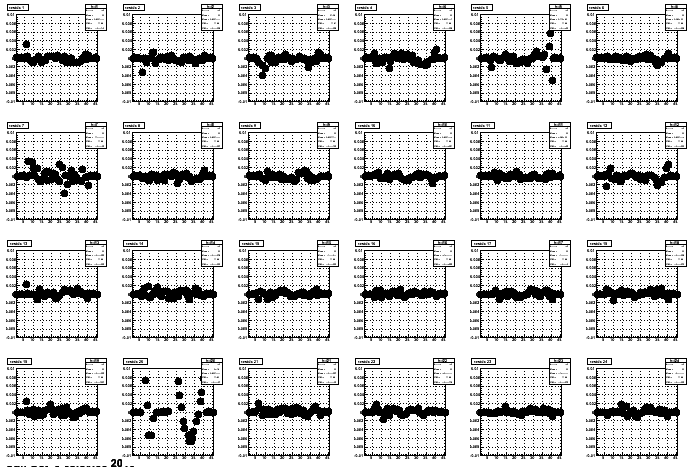News
Updated on Tue, 2010-11-02 22:49. Originally created by matis on 2010-11-02 22:49.SSD biweekly Phone Meeting
2010-11-04 08:00
America/Los Angeles
Thursday, 4 November 2010
+1 510 486 7333, at 12:00 (GMT), duration : 00:00
+1 510 486 7333, at 12:00 (GMT), duration : 00:00
| Time | Talk | Presenter |
|---|---|---|
| 08:00 | News ( 00:20 ) 0 files | Howard |
| 08:20 | Ladder Board Test Card and RDO FPGAs ( 00:20 ) 0 files | Christophe |
| 08:40 | Ladder Board PCB and RDO ( 00:20 ) 0 files | Micheal |
| 09:00 | Cost and Schedule ( 00:20 ) 0 files | Howard |
| 09:20 | Next Meeting Usual Time in Two Weeks? ( 00:20 ) 0 files | |
| 09:40 | AOB ( 00:20 ) 0 files |
Run 10 Calibration Status (2010-11-03)
TPC: A decision was made by the calibration groups that sector 20 be blanked out (gains set to zero in the database) in the Run 10 AuAu 200GeV dataset.
Elliptic flow of light nuclei from Au+Au 200 GeV
Updated on Sat, 2010-11-13 17:38 by cjena. Originally created by psoren on 2010-11-02 15:22.Reference
Speaker : Chitrasen Jena
Talk time : 18:05, Duration : 00:25
Systematics in momentum between MC and RC due to removed SVT
Armen Kechechyan, Michael Tokarev, and Alexandre Alakhverdyants (JINR) reported an observed systematics in reconstructed momenta with respect to simulated ones in region |cos(
Di-lepton production in 200 GeV p+p collisions
Updated on Wed, 2010-11-17 11:53 by huangbc. Originally created by sss on 2010-11-01 12:58.Reference
Speaker : Bingchu Huang
Talk time : 17:00, Duration : 00:30
Monte-Carlo Environment for the STAR High Level Trigger
Updated on Wed, 2010-11-17 11:48 by kehw. Originally created by sss on 2010-11-01 12:57.Reference
Speaker : Hongwei Ke
Talk time : 16:30, Duration : 00:30
Elliptic flow in BES and the tomography of STAR
Updated on Fri, 2010-11-12 22:56 by aschmah. Originally created by sss on 2010-11-01 12:56.Reference
Speaker : Alex Schmah
Talk time : 16:00, Duration : 00:30
Coffee break
Updated on Mon, 2010-11-01 12:55. Originally created by sss on 2010-11-01 12:55.Reference
Talk time : 15:30, Duration : 16:00
FMS-FTPC Correlations from Run-8 Polarized Protons
Updated on Fri, 2010-11-12 13:48 by drach09. Originally created by sss on 2010-11-01 12:55.Reference
Speaker : Jim Drachenberg
Talk time : 15:00, Duration : 00:30
Finding the ground state energy of a many body system using MCMC
Updated on Mon, 2010-11-01 13:03. Originally created by sss on 2010-11-01 12:54.Reference
Speaker : Joseph Seele
Talk time : 12:00, Duration : 00:30
rho0 spectra study at high pT in Au+Au and p+p collisions at sqrt(sNN) = 200 GeV
Updated on Sun, 2010-11-14 00:23 by huangbc. Originally created by sss on 2010-11-01 12:54.Reference
Speaker : Xiangli Cui
Talk time : 11:30, Duration : 00:30
Asymmetric dihadron azimuthal correlations in Au+Au collisions at 200 GeV
Updated on Mon, 2010-11-01 13:36. Originally created by sss on 2010-11-01 12:53.Reference
Speaker : Josh Konzer
Talk time : 11:00, Duration : 00:30
Coffee break
Updated on Mon, 2010-11-01 12:52. Originally created by sss on 2010-11-01 12:52.Reference
Talk time : 10:30, Duration : 00:30
K_{S}^{0} and Lambda v2 in BES
Updated on Fri, 2010-11-12 11:07 by jiezhao. Originally created by sss on 2010-11-01 12:51.Reference
Speaker : Jie Zhao
Talk time : 10:00, Duration : 00:30
First cut of the Y2011 geometry tag
1. Established a first cut of the Y2011 geometry tag by copying the y2010a geometry and removing the PMD.
Draft of pre-DNP 2010 Spin Highlights Talk
In version 6 I made the following changes:
1) Changed the proton sum rule to the proton sum and it is now 1/2 = 1/2DSigma +DG +L

